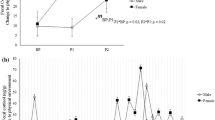Abstract
As a solitary species, rat-like hamsters (Cricetulus triton) still live in family groups before they become mature and leave their families for a solitary life. This study aimed to investigate by a laboratory experiment if housing conditions have a different effect on physiological aspects of immature and mature females. We found that paired caged adult females became significantly heavier than their original weights; whereas the singly caged did not show significant change in their body weight. Although the subadults’ body weights increased significantly compared to their initial weights in both paired or singly caged groups, significant changes in body weight did not occur between the two groups. Although spleen and adrenal gland sizes were not significantly different between the two adult groups, the cortisol levels were significantly elevated by paired caging. In subadults, the adrenal size of the singly caged group was larger than that in the paired caged group despite there being no significant difference in cortisol level. Flank glands became significantly larger in paired caged adults than in singly caged adults, and there were no significant differences in subadults between the two groups. Additionally, ovaries and uteri of the paired caged adult females were comparatively lighter than those of the singly caged group; in contrast, ovaries and uteri of the paired caged group were larger than those of the singly caged group in subadults, although progesterone and estradiol levels did not show significant differences between the two adult groups. These different changes in physiological traits caused by housing conditions indicated that paired caging depressed adults and facilitated subadults; isolation facilitated adults and depressed subadults.
Similar content being viewed by others
References
Bartness TJ (1996) Photoperiod, sex, gonadal steroids, and housing density affect body fat in hamsters. Physiol Behav 60:517–529
Borer KT, Pryor A, Conn CA, Bonna R, Kielb M (1988) Group housing accelerates growth and induces obesity in adult hamsters. Am J Physiol 255:R128–R133
Bronson FH, Champman VM (1968) Adrenal–estrus relationship in grouped or isolated mice. Nature 218:483–484
Creel S (2001) Social dominance and stress hormones. Trends Ecol Evol 16:491–497
Ebling FJ (1977) Hormonal control of mammalian skin glands. In: Müller-Schwarze D, Mozell MM (eds) Chemical signals in vertebrates. Plenum Press, New York, pp 17–33
Fritzsche P, Riek M, Gattermann R (2000) Effects of social stress on behavior and corpus luteum in female golden hamsters (Mesocricetus auratus). Physiol Behav 68:625–630
Human KL, Mougey EH, Moore TO, Meyerrhoff JL (1995) Stressors, including social conflict, decrease plasma prolactin in male golden hamsters. Horm Behav 29:581–592
Li Z (1985) Radioimmunoassays of hormones (in Chinese). Sciences and Technology Press, Beijing
Marchlewska-Koj A, Pochron E, Galewicz-Sojecka A, Galas J (1994) Suppression of estrus in female mice by the presence of conspecifics or by foot shock. Physiol Behav 55:317–321
Meisel RL, Hays TC, Del Paine SN, Luttrell VR (1990) Induction of obesity by group housing in female Syrian hamsters. Physiol Behav 47:815–817
Palanza P, Gioiosa L, Parmigiani S (2001) Gender differences and effects of estrous cycle and social dominance. Physiol Behav 73:411–420
Wang S, Yang H, Hao S (1996) Activity range, activity rhythm and food preference in rat-like hamsters (Cricetulus triton) (in Chinese). Chin J Zool 31:28–31
Wolff JO (1997) Population regulation in mammals: an evolutionary perspective. J Anim Ecol 66:1–13
Yang H, Wang S, Hao S (1996) An investigation on populations of rat-like hamsters (Cricetulus triton), their predication and the integrated management in the non-irrigated area on North China Plain, China. In: Wang Z, Zhang Z (eds) Theory and practice of rodent pest management (in Chinese). Science Press, Beijing, pp 229–246
Yang H, Wang S, Hao S (1999) Growth and development of the rat-like hamster (Cricetulus triton). Zoological Studies in China. Chinese Zoology Society. China Forestry Press, Bijing, China, pp 896–906
Zhang Z, Zhu J, Yang H (1992) Estimation of age-specific survival rate of rat-like hamster (in Chinese). Acta Zool Sin 39(1):56–63
Zhang J, Wang Z, Zhang Z (1999a) A preliminary study of effects of estradiol on flank glands in rat-like hamsters (Cricetulus triton) (in Chinese). Acta Theriol Sin 19(4):262–266
Zhang J, Zhang Z, Wang Z (1999b) Development and sexual differences in flank glands of rat-like hamsters (Cricetulus triton) (in Chinese). Acta Zool Sin 45:390–397
Zhang J, Zhang Z, Wang Z (1999c) Effects of sex hormones on behavioral interaction between male and female rat-like hamsters, Cricetulus triton. In: Chinese Zoology Society (ed) Zoological studies in China (in Chinese). China Forestry Press, Beijing, pp 633–638
Zhang J, Zhang Z, Wang Z (2001a) Seasonal changes in and effects of familiarity on agonistic behaviours of rat-like hamsters (Cricetulus triton). Ecol Res 14:309–317
Zhang J, Zhang Z, Wang Z (2001b) Scent, social status and reproductive conditions in rat-like hamsters (Cricetulus triton). Physiol Behav 74:415–420
Zhang J, Cao C, Gao H, Yang Z, Sun L, Zhang Z, Wang Z (2003) Effects of weasel odor on behavior and physiology of two hamster species. Physiol Behav 79:549–552
Zhang J, Cao C, Gao H, Yang Z, Ni J, Wu F, Zhang Z, Wang Z (2004) Sexual and age’s differences in responses of ratlike hamsters (Cricetus triton) to predator’s odor (in Chinese). Acta Zool Sin (in press)
Acknowledgements
We express our gratitude to Beijing Institute of Immunoassay for Hormonal Immunoassay and Fu-Sheng Wang and Jin-Hua Zhang for their capture and care of the hamsters. Dr. Lixing Sun provided valuable comments on the draft. The work was supported by grants from the Chinese NSF (39970110, 39730090 and 39825105) and the Chinese Academy of Sciences (KSCX2-1-03, KSCX2- SW-103 and KSCX2-SW-105), and Ministry of Science and Technology (FS2000-009).
Author information
Authors and Affiliations
Corresponding author
About this article
Cite this article
Zhang, JX., Ni, J., Wu, FY. et al. Effects of social conditions on adult and subadult female rat-like hamsters (Cricetulus triton). J Ethol 22, 161–165 (2004). https://doi.org/10.1007/s10164-004-0117-3
Received:
Accepted:
Published:
Issue Date:
DOI: https://doi.org/10.1007/s10164-004-0117-3




